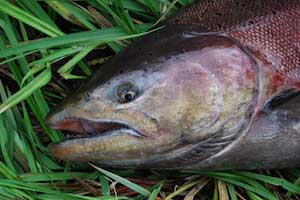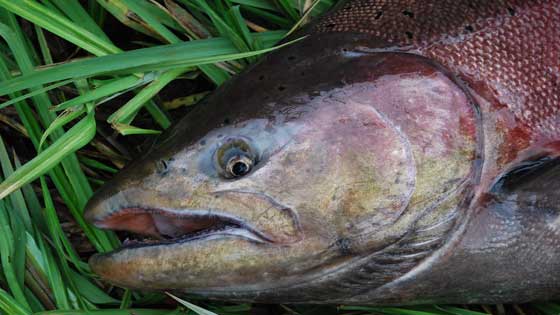Chinook Salmon Habitat

Spawning Chinook Salmon prefer gravel to rocky rivers with stones in the 2 to 3 inch range. The gradient range is between 1 to 4 inches, but if the gravel appears to be unstable they will move on. They won’t lay their eggs where there’s a chance the eggs will get crushed.
Water depth for their redd is between 20 to 36 inches most of the time, although they have spawned in much less. In fact as little as 10 inches.
The water flow rate is often around 3 feet per second when they’re spawning in late summer or early fall depending on their distribution. Water temperature must be within the range of 42°F to 51°F. If the temperature is much out of this this range, they won’t spawn.
The Ideal Chinook Salmon Fry and Parr Habitat
Chinook Salmon hatch starting in March, but may be later in some parts of their distribution and will stay in the general area of their birth for about a year, hiding in and amongst the gravel. Their spawning spots are in the head-water streams and rivers in which they are born.
Water flow in their habitat is just a notch above still water, but is most definitely flowing.
When fall arrives, they move downstream from their headwaters as ice can freeze down to the gravel in many headwaters.
The ideal water temperature for Salmon Fry and Parr is between 53°F to 60°F/11.6°C to 15.5°C. They can easily adapt to water quickly if it’s a bit below, to around 53°F/11.6°C, but cannot tolerate water above 75°F/23.9°C for very long.
Avoid looking for them in water above 70°F as they’re not likely to be there in much abundance, if at all. And if you do find them, they won’t feel much like feeding.
For more information on King Salmon spawning click on this link.
Food Preferences for Parr
Chinook Salmon are not fussy eaters, but they do tend to binge on the most popular bait fish or other food type at the time. However, at this Parr stage of their development, they have a greater concern about being food themselves.
Predators
Herons, otters and kingfishers are probably their biggest concern. They also have to worry about other fish including northern pike and bull trout, though others will take a liking to them as well.
Chinook Salmon Smolt Habitat
Smolt are not that much different from Parr in what they’ll eat, their water temperature preferences or the depth that they enjoy.
Chinook, or King Salmon Adult Habitat
Adult Chinook Salmon don’t have to worry about predators in the same way as the younger fish. However, they do have to deal with bears when it comes to spawning. They also have to deal with humans as well. Water depth varies depending on where they are in the ocean or in a river.



